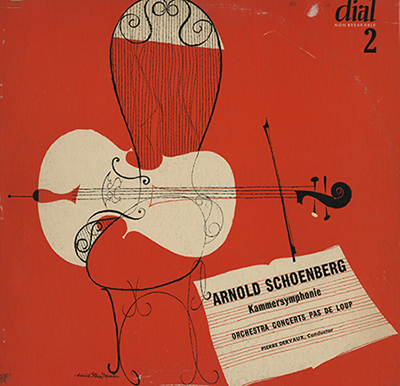The LPs released by DIAL Records in the 1950s present some of the earliest commercial recordings of Schönberg’s music, and thus serve as important documents for the performance history of works of the Second Viennese School during that time.
Ross Russell was an American author of detective stories and an avid jazz fan. In 1946 he founded the DIAL Records label, and released recordings of musicians associated with the bebop era, including Charlie Paker, Miles Davis and Max Roach. In 1949, Russell received the master tape of a recording of Arnold Schönberg’s Kammersymphonie No. 1, Op. 9, performed by members of the Orchestre des Concerts Pasdeloup and conducted by Pierre Dervaux. This master tape was sent to him in exchange for a set of jazz tapes Russell had sent to France for European distribution. On August 15, he asked Schönberg for an introductory text about the work: “One of your students [...] got me interested in Schoenberg and atonal music over two years ago and I have been hopeful ever since of being able to record it.” (August 15, 1949) With the recording he had received from Paris, Russell planned to establish a new focal point for his label that would be centered around contemporary classical music. Schönberg reacted with cautious interest: “Mr. Steuermann, my friend, had already written me about your plans, but that the Kammersymphonie has been recorded by Mr. Dervaux, in France is new to me. [...] I am very glad that you want to publish these records, but I think, at least if I cannot hear these records myself at first, so that I know whether they are at all good, then at least Mr. Steuermann should hear them and tell them whether there are not great mistakes or something else. I hope they might be good, because a man who undertakes such a thing is generally a good musician, but one never knows.” The recording was released on December 23, with Schoenberg’s introduction included on the back cover. At first it was available exclusively through a New York dealer, who sold 50 copies in three days. On January 7, 1950, Russell informed Schönberg of the commercial success of the record, but he also admitted “that the Kammersymphonie recording is really not very good [...]. They did it for us, because we wanted a Schoenberg work, but we had no control over the artists or performance. It was strictly a take it or leave it arrangement and since we were owed money by them which we had been unsuccessful in collecting we ʽtook’. [...] Also the recording quality is not up to our standards.” The listening impression confirms this assessment: the instrumental lines are not properly balanced, and some tempi seem to have been chosen primarily in order to accomodate the technical capabilities of the ensemble and not because of musical considerations. Additionally, the record itself, which is over 70 years old, is in poor condition. As a historical sound document (→ https://bit.ly/DIAL-DLP2), the LP conveys an impression of the not always ideal performing conditions for Schönberg’s works that existed in Europe at the time. Above all, however, as the first commercial recording of the work, it marked the beginning of a series of important recordings by performers familiar with Schönberg’s oeuvre, which will be made available by the Arnold Schönberg Center in the coming months.

